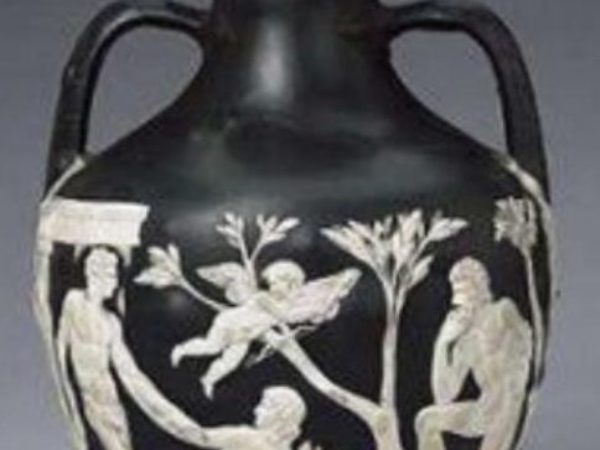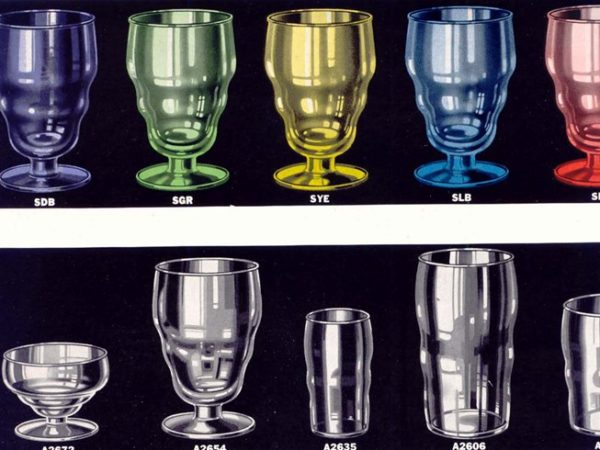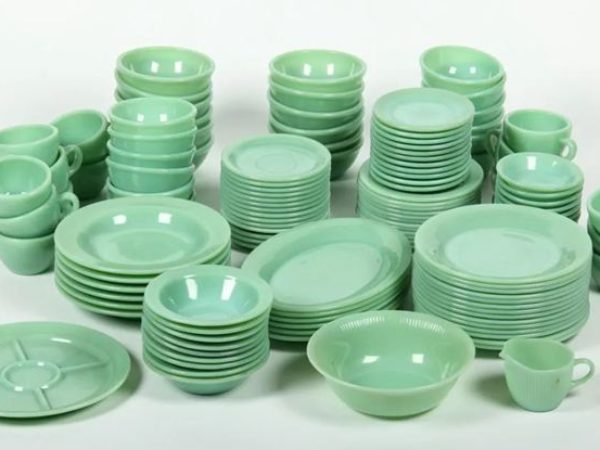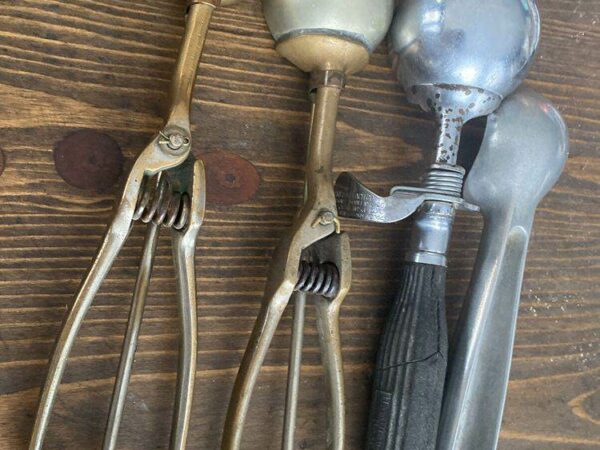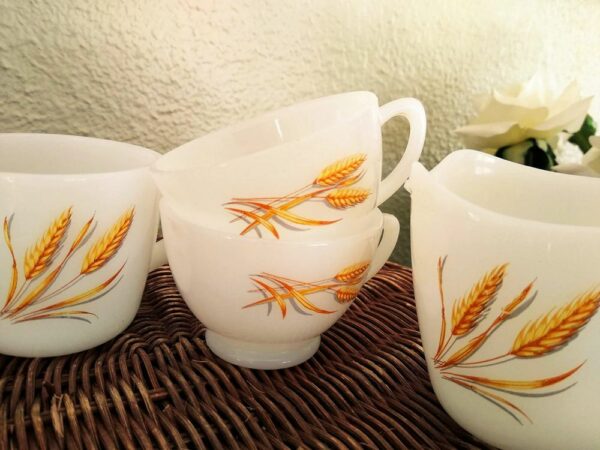Are you looking for a classic vintage item with practical value for your home? Do you also require that item to be durable, even if it is an antique? An antique pot belly stove is the perfect item! This sturdy mid-nineteenth-century invention functions effectively and stylishly as a cooking appliance and as a source of heating for the home.
This is a good choice for those who don’t use stoves because they’re not eco-friendly. This antique stove is fancier and more functional than regular ones. From its decorative handles to its intricate body detailing, it’s a great piece for antique collectors.
If you’re looking for more information on antique pot belly stoves, such as how to identify them and how much they’re worth, you’ve come to the right place! This article will help you with all of that and more. After reading this, you’ll be an expert on antique pot belly stoves.
Table of Contents
What Is An Antique Pot Belly Stove?
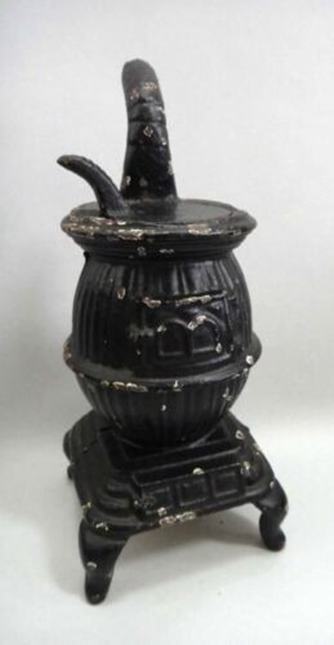
A pot belly stove is a type of wood-burning stove named after overweight men with big bellies. Antique pot belly stoves, easily identified by the large bulge in the mid-center section, are great multitaskers that gained popularity in 1860.
The first ones were made of cast iron, as opposed to the newer versions, which are made of steel. These cast-iron pot belly stoves have two doors. The top door leads to a loading area for wood or coal, while the second or bottom door is used to remove ashes.
The exhaust pipes and flat tops are functional designs and important features of an antique pot belly stove. Due to its widespread popularity at the time, this stove has significant historical significance and is therefore highly sought after by collectors today.
History of the Pot Belly Stove
Despite the stove’s widespread popularity and usefulness in the mid-1990s, it’s uncertain who invited the stove. It is known that a patent was filed during that time, but people had been using it long before then.
The first record of this cast iron pot belly stove was from 1800 to 1820s, by an author, Robert Bailey Thomas, in his book, The Old Farmer’s Almanac. The stove became popular in the mid-1990s and early twentieth century.
It was first associated with train stations, cabooses, and hunting lodges before becoming a heater in schools, homes, and cabins. Because of their inability to meet the new standards, pot belly stoves gradually faded away.
The Environmental Protection Agency enforced a regulation that required fireplaces, stoves, and other items in the wood-burning industry would fall under a certain pollution level.
The regulation prompted manufacturers to ensure that not only the wood but also the smoke emitted was burned. This is known as secondary combustion.
However, the number of grams allowed per hour keeps reducing after every set number of years, making it difficult for the manufacturers to meet the strict requirements. As a result, most small builders shut down or built other stoves that could meet the guidelines.
The pot belly stoves simply were not good enough for the environment. In today’s era of environmental consciousness, the amount of smoke they emitted was excessive.
A clear display of the changing times is even seen in the building codes and insurance restrictions placed on wood stoves made before that regulation was enforced.
Now, more contemporary stove designs like Vermont Castings and Hearthstone are emerging. These new stoves have glass doors so that users can see their fires, in contrast to older stoves that were made entirely of cast iron.
All of these factors have rendered pot belly stoves obsolete, and they are now seen as antiques. But not just any antiques—very valuable ones. Finding one in an estate sale or antique store is a good find because these stoves earned their way into the classic 1900s makes.
Pot Belly Stove Identification
When looking for a pot belly stove, it is easy to confuse it with other types of stoves, especially if they share certain characteristics. However, a pot belly stove has a few distinguishing characteristics, which are as follows:
● Potbelly
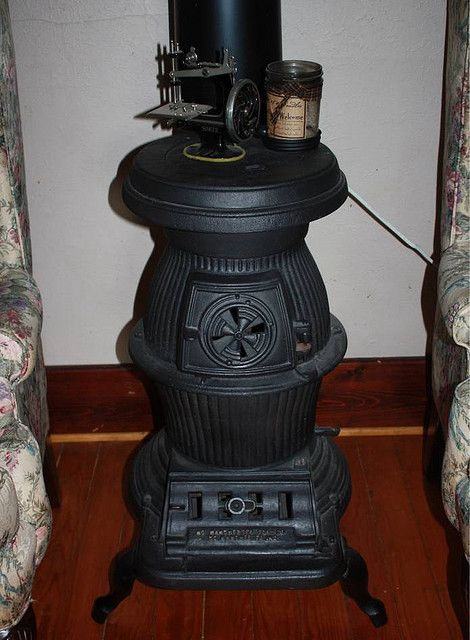
The potbelly, as the name suggests, is the main feature of a pot belly stove. This barrel-shaped feature is located in the stove’s center, giving it a round, bulbous center with a narrow top and bottom section.
The middle of a potbelly stove also has a rim called a skirt rail. This skirt rail looks like a small trim, and some have detailed designs and are designed to hold a variety of cooking utensils.
● Material

Most modern potbelly stoves are made of steel, whereas their older counterparts are made of cast iron. The cast iron potbelly stove has two doors.
The two doors, one large and one small, are both made of cast iron; the larger one is used to load wood or coal, and the smaller one is used to remove ashes.
Check to see what material the top door is made of because glass is used in modern stoves but not in antique potbelly stoves.
● Flat Top
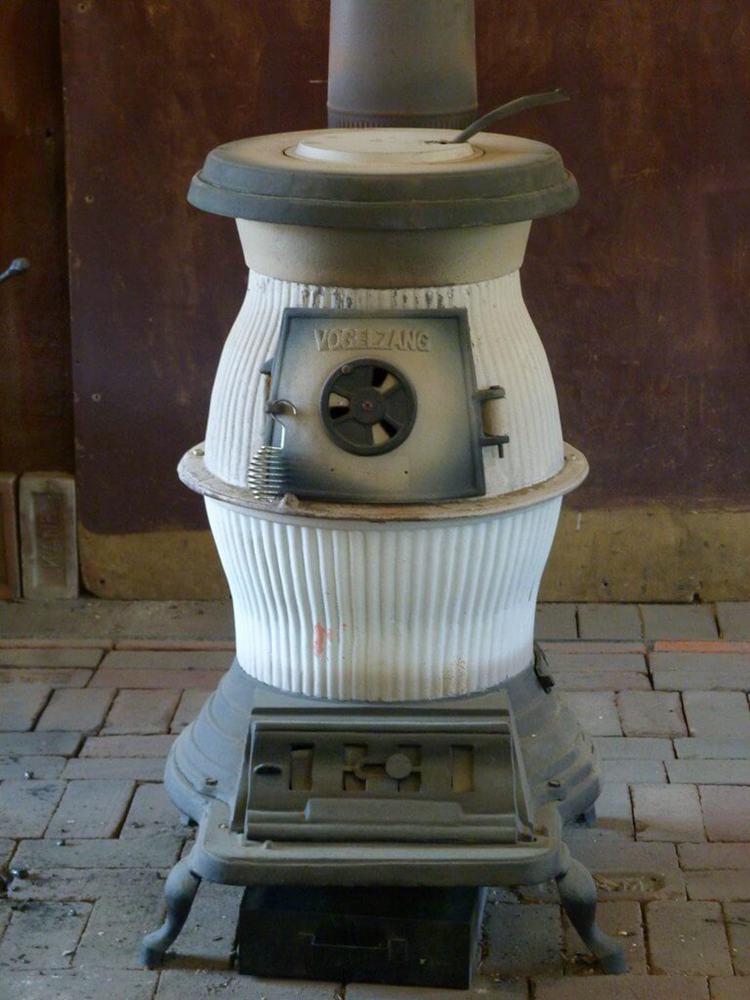
The potbelly stove can be used for both cooking and heating. Due to this, the top of the stove should be flat to create a hot cooking surface. Some of these stoves have domes that are lifted to reveal flat cooktops.
This area is usually wide, flaring out to be nearly as large as the rounded center part of the potbelly burn pot.
● Exhaust Pipe
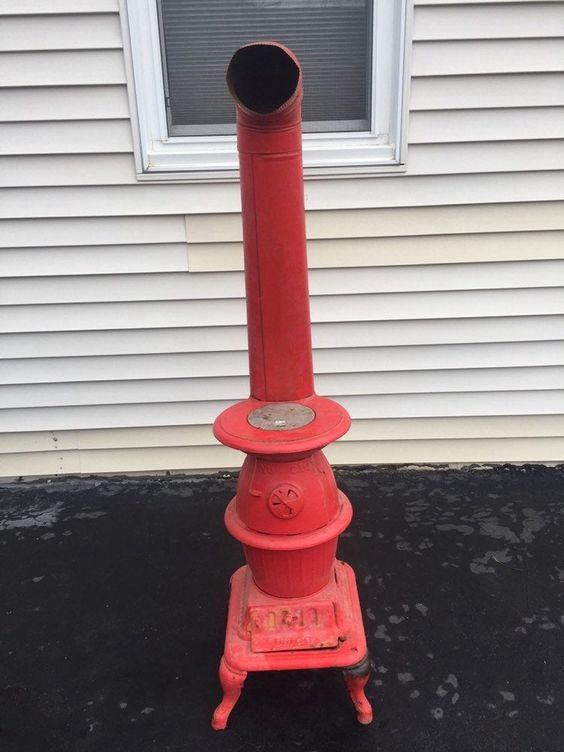
Another important feature of a potbelly stove is the exhaust pipe. They are often large and black, extending upward from the top cook plate, though some are positioned on the side of the burn pot.
Also, potbelly stoves can be converted to burn gas rather than wood; in this case, they must have adequate ventilation for safe use.
Factors Affecting the Value of a Potbelly Stove
Various factors could contribute to a potbelly stove’s value, which can greatly affect its worth or how much it would be priced. These factors are discussed below:
Age
The stove’s age is a major factor in determining its value. If you want an antique stove, expect to pay more because they are more expensive because they are older and rarer.
Similarly, looking at antique stoves in your family for several generations, they will most likely be in good condition because of their durability and cost more than newer stoves made using modern manufacturing techniques.
Condition
Stoves in good condition cost more than stoves in poor condition because they are easier to operate and safer. Even if you believe your stove is in good shape and ready for use, you should always check it out to ensure there are no significant problems with it.
Brand
Your stove’s brand will most likely affect how much it is worth and how much you have to pay for it. Because these stoves are more widely available, you can often anticipate paying more if you purchase one from a reputable manufacturer.
The brand of your stove will most likely influence how much it is worth. Due to increased competition in the market, quality brands of these stoves tend to cost more.
Location
It is best to keep in mind the location of your stove to get the best value. If you want to buy a stove near you, it is best to look for one with easy access.
However, if you’re interested in stoves in another state or even another country, shipping them to you will cost you more money.
Fuel Type
The type of fuel your stove uses will also affect the price you pay for it, as wood-burning stoves are more expensive. Also, note that a stove with a modern fuel source will cost less than one with a more traditional fuel source.
Determining the Worth of An Old Pot Belly Stove
You need to know how much your antique pot belly stove is worth before you can sell it or even buy one.
Aside from the factors mentioned above that make a cast iron stove valuable, other factors, such as the preferences of modern collectors, can affect the value of these classic home pieces.
While a bit of wear and tear adds charm to many antiques, pot belly stoves are an exception. Collectors prefer antique stoves with minimal wear and tear for use as home decor.
A well-painted cast iron pot belly stove is also preferred. Unlike other antiques, a well-done refurbishing job on your potbelly stove will increase its value.
Collectors lean more toward larger, free-standing potbelly stoves than “doll-sized” versions. It’s even better if it’s made by a company with more obvious and better designs, like C. Emrich. These will sell at significantly higher prices.
Here are some examples of antique cast iron pot belly stoves and their prices:
- 14” Vintage Spark Cast Iron Pot Belly Stove Salesman Sample, 14”– sold for $249.
- Klondike pot belly wood burning stove– sold for $750.
- Emrich Hot Blast Florence 750 stove– not available on eBay but sold for $1500 on Machinio.
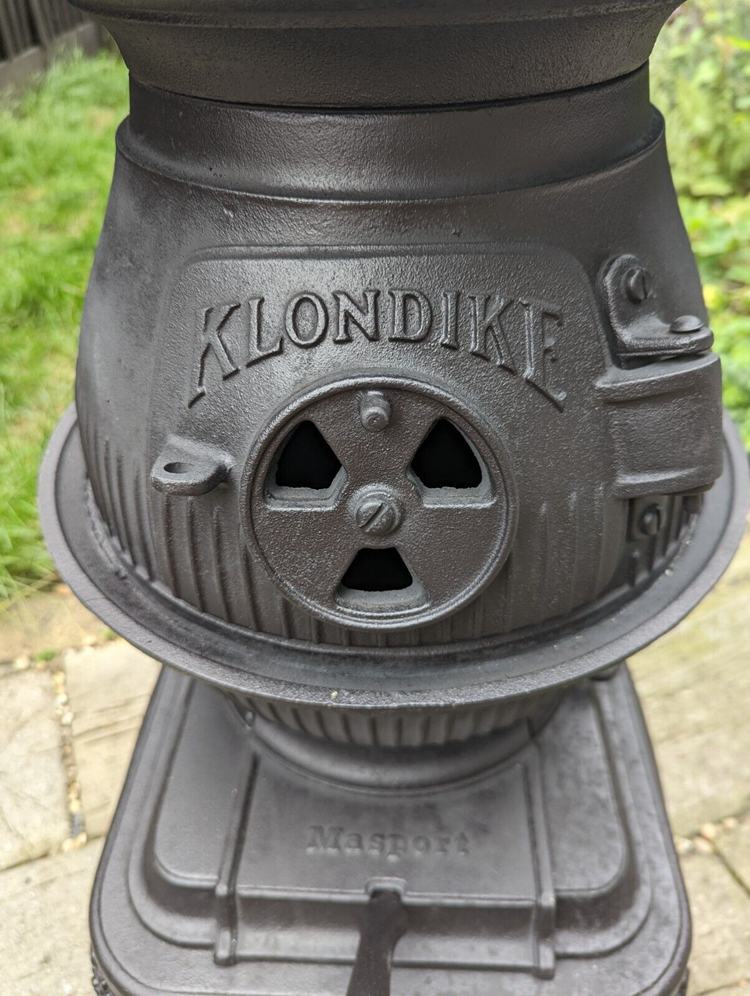
While checking the prices is a great way to learn about the prices, you can also ask a professional antique appraiser for help.
These days, you can use online appraisers to make things easier. Take photographs of the antique stove and include all the necessary details before posting them online for appraisers to evaluate.
Antique Pot Belly Stove Prices In Different Conditions
As previously stated, the condition of the antique pot belly stove is crucial. Here are the price ranges of pot belly stoves according to their conditions:
Damaged Antique Belly Stove or Antique Pot Belly Stove Parts
Once the antique pot belly stove is damaged, it won’t be of much value, and it’ll be better off if you sell its parts. Some parts of the stove can also be sold separately rather than as a damaged whole.
Damaged pot belly stoves and parts are available on eBay for prices ranging from $19.99 to $600, depending on the seller, the level of the damage, and the make.
Pre-owned Antique Stoves
Used pot belly stoves would still function properly in most cases. Some of them might look very old and may not be the most aesthetically pleasing.
Therefore, to make it fit in, you may need to refurbish it. This includes cleaning it out by removing debris like dust and ash particles.
Fully-Refurbished Antique Stoves
Antique potbelly stoves that have been restored and are in good working order are highly valued possessions.
Even if they do not appear antique, they are still excellent because being fully refurbished means they are in excellent working order and also look good. Goodtime offers fully refurbished antique belly stoves for as much as $4500.
Frequently Asked Questions
How Do You Clean An Old Pot Belly Stove?
Clean out the bigger part of the dirt with a shovel, then blow out other debris with a vacuum cleaner with a hose. Finally, wipe it out with a damp cloth.
How Do I Remove Rust From My Pot Belly Stove?
A stiff wire brush can be used to remove rust from a pot belly stove. After that, smooth the brushed surfaces with 220-440 grit sandpaper. Blow off the rust, and it looks new.
Can I Paint My Potbelly Stove?
Yes, you can but use paint that can withstand high temperatures and is specifically designed for stoves and grills.
Final Thoughts
Antique cast iron pot belly stoves were a favorite at the time they were made. Due to the attention they got from people, they were widely produced by several manufacturers and in different styles.
Some can be used as a source of heat, while others can be used to cook. Depending on your preferences, you can get cast iron from any manufacturer to spice up your decor or for your collection. Please leave your comments and questions in the section below.
